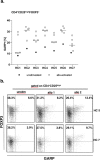Transient increase of activated regulatory T cells early after kidney transplantation
- PMID: 30705299
- PMCID: PMC6355855
- DOI: 10.1038/s41598-018-37218-x
Transient increase of activated regulatory T cells early after kidney transplantation
Abstract
Regulatory T cells (Tregs) are crucial in controlling allospecific immune responses. However, studies in human kidney recipients regarding the contribution of polyspecific Tregs have provided differing results and studies on alloreactive Tregs are missing completely. In this retrospective study, we specifically analyzed activated CD4+CD25highFOXP3+GARP+ Tregs in 17 patients of a living donor kidney transplantation cohort longitudinally over 24 months by flow cytometry (FOXP3: forkhead box protein 3, GARP: glycoprotein A repetitions predominant). We could demonstrate that Tregs of patients with end-stage renal disease (ESRD) are already pre-activated when compared to healthy controls. Furthermore, even though total CD4+CD25highFOXP3+ Treg numbers decreased in the first three months after transplantation, frequency of activated Tregs increased significantly representing up to 40% of all peripheral Tregs. In a cohort of living donor kidney transplantation recipients with stable graft function, frequencies of activated Tregs did not correlate with the occurrence of acute cellular rejection or chronic graft dysfunction. Our results will be important for clinical trials using adoptive Treg therapy after kidney transplantation. Adoptively transferred Tregs could be important to compensate the Treg loss at month 3, while they have to compete within the Treg niche with a large number of activated Tregs.
Conflict of interest statement
The authors declare no competing interests.
Figures







Similar articles
-
Effect of regulatory T cells on short-term graft outcome in kidney transplant recipients, a prospective observational, single-center study.Transpl Immunol. 2022 Aug;73:101630. doi: 10.1016/j.trim.2022.101630. Epub 2022 May 25. Transpl Immunol. 2022. PMID: 35643376
-
Evaluation of CD4+ CD25+/- CD39+ T-cell populations in peripheral blood of patients following kidney transplantation and during acute allograft rejection.Nephrology (Carlton). 2017 Jul;22(7):505-512. doi: 10.1111/nep.12894. Nephrology (Carlton). 2017. PMID: 27517975
-
Absolute of CD4(+)CD25(+)FOXP3(+) regulatory T-cell count rather than its ratio in peripheral blood is related to long-term survival of renal allografts.Transplant Proc. 2012 Jan;44(1):284-6. doi: 10.1016/j.transproceed.2011.12.014. Transplant Proc. 2012. PMID: 22310634
-
Regulatory T cells in kidney disease and transplantation.Kidney Int. 2016 Sep;90(3):502-14. doi: 10.1016/j.kint.2016.03.022. Epub 2016 Jun 3. Kidney Int. 2016. PMID: 27263492 Review.
-
Regulatory T Cells and Kidney Transplantation.Clin J Am Soc Nephrol. 2018 Nov 7;13(11):1760-1764. doi: 10.2215/CJN.01750218. Epub 2018 May 22. Clin J Am Soc Nephrol. 2018. PMID: 29789350 Free PMC article. Review.
Cited by
-
Skewed T cell responses to Epstein-Barr virus in long-term asymptomatic kidney transplant recipients.PLoS One. 2019 Oct 22;14(10):e0224211. doi: 10.1371/journal.pone.0224211. eCollection 2019. PLoS One. 2019. PMID: 31639143 Free PMC article.
-
Regulatory T cells in autoimmune kidney diseases and transplantation.Nat Rev Nephrol. 2023 Sep;19(9):544-557. doi: 10.1038/s41581-023-00733-w. Epub 2023 Jul 3. Nat Rev Nephrol. 2023. PMID: 37400628 Review.
-
Analysis of T-Cell Receptor Repertoire in Transplantation: Fingerprint of T Cell-mediated Alloresponse.Front Immunol. 2022 Jan 12;12:778559. doi: 10.3389/fimmu.2021.778559. eCollection 2021. Front Immunol. 2022. PMID: 35095851 Free PMC article. Review.
-
Regulatory Immune Cell-derived Exosomes: Modes of Action and Therapeutic Potential in Transplantation.Transplantation. 2025 Jul 1;109(7):1124-1137. doi: 10.1097/TP.0000000000005309. Epub 2025 Jan 27. Transplantation. 2025. PMID: 39865513 Review.
-
M2c Macrophages Protect Mice from Adriamycin-Induced Nephropathy by Upregulating CD62L in Tregs.Mediators Inflamm. 2022 Oct 10;2022:1153300. doi: 10.1155/2022/1153300. eCollection 2022. Mediators Inflamm. 2022. PMID: 36262548 Free PMC article.
References
-
- Jaeckel, E., von Boehmer, H. & Manns, M. P. Antigen-specific FoxP3-transduced T-cells can control established type 1 diabetes. Diabetes54, 306-310, 54.02.04.db04-1252 (2005). - PubMed
Publication types
MeSH terms
LinkOut - more resources
Full Text Sources
Medical
Molecular Biology Databases
Research Materials

